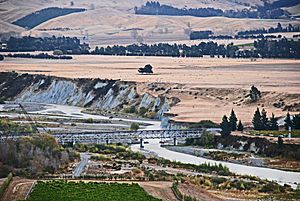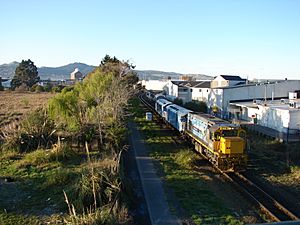Main North Line, New Zealand facts for kids
Quick facts for kids Main North Line |
|
|---|---|

Start of the Main North Line, heading north under the old Blenheim Road overpass in the distance, and to the left under the new Blenheim Road overpass to Christchurch railway station. The original route of the line was just to the right of the photographer.
|
|
| Overview | |
| Status | Operational |
| Locale | South Island, New Zealand |
| Termini | Addington, Christchurch Picton, Marlborough |
| Stations | 65 (total) 18 (operational) |
| Service | |
| Type | Regional rail |
| System | KiwiRail |
| Operator(s) | KiwiRail |
| History | |
| Opened | 1872-04-29 |
| Technical | |
| Line length | 348.04 km |
| Number of tracks | Single |
| Character | Main Line |
| Track gauge | 3 ft 6 in (1,067 mm) |
The Main North Line is a super important railway line in New Zealand. It travels along the east coast of the South Island, starting in Christchurch and heading north through towns like Kaikōura and Blenheim, all the way to Picton. This line helps connect the South Island's rail network to the North Island, as trains can link up with ferries in Picton that go to Wellington. It took a very long time to build – from the 1870s until 1945!
Contents
Building the Main North Line
Early Ideas for the Railway
People first thought about building a railway like the Main North Line way back in 1861. There was an idea to connect Christchurch and Blenheim. The government even passed a law to approve a line from Picton to the Wairau River.
However, nothing was actually built in the 1860s. Building railways takes a lot of planning and money.
Starting Construction in the South
The Canterbury Provincial Railways started building tracks north from Christchurch. They used a wider track size at first. They reached Kaiapoi in 1872 and Rangiora later that year.
By the time they reached Amberley in 1876, the tracks were changed to the national size. This is a narrower track size, 1,067 mm (3 ft 6 in), which is still used today. The government then took over these railway lines.
Building from the North
In the north, a railway from Blenheim to Picton was one of the first projects under a big government plan. This plan was called Vogel's "Great Public Works Policy". This part of the line was approved in 1870.
Debates and Delays
In the 1880s, building work almost stopped. People argued a lot about which route the railway should take. Some thought an east coast line was not needed yet. But people in different regions wanted the line to go their way.
Canterbury slowly kept building its "Great Northern Railway" inland from Waipara. It reached Culverden in 1886.
In 1882, a special group studied different ideas for the northern line. They looked at routes like:
- From Culverden to Hanmer Springs and then splitting to Nelson and Blenheim.
- From Culverden to the West Coast, then to Nelson.
- From Waipara along the coast to Blenheim, passing through Parnassus and Kaikōura.

People in Marlborough wanted the coastal route. They started building south from Blenheim. This line reached Seddon in 1902 and Ward in 1911. It got to Wharanui before World War I started.
Canterbury seemed unsure about its northern route. After about 15 years, they started building a coastal "branch" from Waipara. This line reached Cheviot in 1910. In 1912, it crossed the Waiau River on a long bridge and opened to Parnassus.
World Wars and Completion
World War I stopped most construction. The tracks beyond Parnassus were even removed. However, a line from Culverden to Waiau was finished in 1919. This gave hope to those who wanted an inland route. But this idea didn't go anywhere.
In the 1920s, not much progress was made. Different groups kept arguing about the best route. The idea of a coastal route from Parnassus, which is the route we have today, started to form around this time.
Building finally started again on the coastal line south of Wharanui in the late 1920s. But it stopped again because of the Great Depression. People really wanted the work to restart. When the economy got better in 1936, the government ordered the line to be finished in four years.
In 1939, the line beyond Parnassus opened to Hundalee. But then World War II started, causing more delays. Construction continued through the war. Soon after the war ended, the northern and southern parts of the railway met in Kaikōura. The Main North Line was finally finished and officially opened on 15 December 1945.
Railway Stations
The government department in charge of public works named new stations. Sometimes, local people didn't like the names. For example, in 1914, a station was going to be named "Mills" after a local politician. But locals asked for a Māori name or a name about plants. So, it was called "Wharanu".
Another time, a local group couldn't agree on a name. They decided to use the first words said by a member who arrived late. When the chairman told him this, the member immediately said "No! Not I". So, "No Noti" (later "Nonoti") became the official name for that small station!
How the Line Operates

Before the railway was fully connected, the Canterbury section ended in Culverden. The most important passenger train was the Culverden Express. When the Waiau Branch reached Waiau in 1919, more trains were added. The section between Christchurch and Rangiora also had trains for people commuting to work.
In the mid-1920s, Parnassus became the main end point for trains. During this time, trains were tested with a special red paint scheme. This "Midland Red" became the standard color for passenger carriages across New Zealand until the 1990s.
When the entire line was finished in 1945, the Picton Express train started running. It left Christchurch at 8:25 AM and arrived in Picton at 4:35 PM. This was much faster than before.
Later, in 1956, new railcars were used. These railcars were faster, cutting the journey time to 7 hours with many stops. By 1959, it was even faster, taking 6 hours and 40 minutes.
Coastal Pacific Train
The beautiful views along the route, especially near Kaikōura, led to a special tourist train. This train was called the Coastal Pacific. It started in 1988 and traveled between Christchurch and Picton in 5 hours and 20 minutes. In 2000, it was renamed the TranzCoastal.
The TranzCoastal train had to stop for a while after the 2011 Christchurch earthquake. It started again in August 2011, going back to its original name, Coastal Pacific.
The line was badly damaged by the 2016 Kaikōura earthquake. Many parts of the track were covered by huge slips of earth. It took a lot of work to fix the line. Limited freight services started again in September 2017.
In 2018, the Prime Minister announced that money would be given to KiwiRail. This money would help the Coastal Pacific train run all year round. It would also help upgrade the stations in Kaikōura, Blenheim, and Picton.
Moving Freight
The amount of freight carried by trains increased a lot over the years. In 1952, there were 15 southbound freight trains a week. By 2001, there were 36! Before the 2016 earthquake, about a million tonnes of goods were moved each year.
For a while, some rail freight was even flown by plane between airports. This happened from 1946 to 1983. But it became less common after the Interislander ferry service started in 1962.
Types of Locomotives
At first, steam locomotives like the A, J, and JA were used. After the line was finished in 1945, AB class locomotives did most of the work.
Between 1962 and 1968, diesel locomotives started to take over from steam engines. First, there were DG class diesels, then DJ class from 1968. Later, DF class and DX class locomotives were used.
Branch Lines
The Main North Line starts where it separates from the Main South Line in Christchurch. Unlike the Main South Line, not many smaller railway lines, called branch lines, connected to the Main North Line. The three that did were:
- The Eyreton Branch (closed in 1954)
- The Oxford Branch (closed in 1959)
- The Waiau Branch (closed in 1978)
In 1960, there was a plan to build a line connecting Nelson and Blenheim. But a change in government meant this project was stopped. Today, no lines branch off the Main North Line. However, the first 13 km of the old Waiau Branch has been fixed up. It is now the Weka Pass Railway, a heritage railway, and it still connects to the Main North Line in Waipara.


